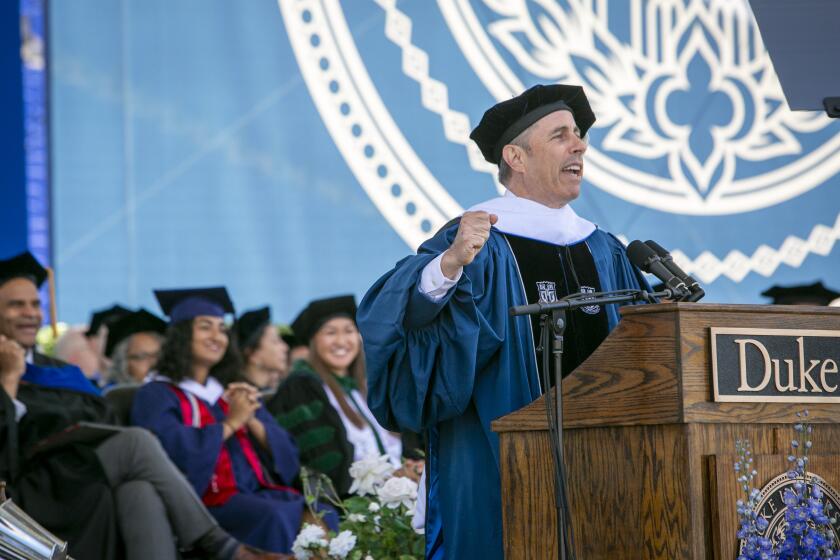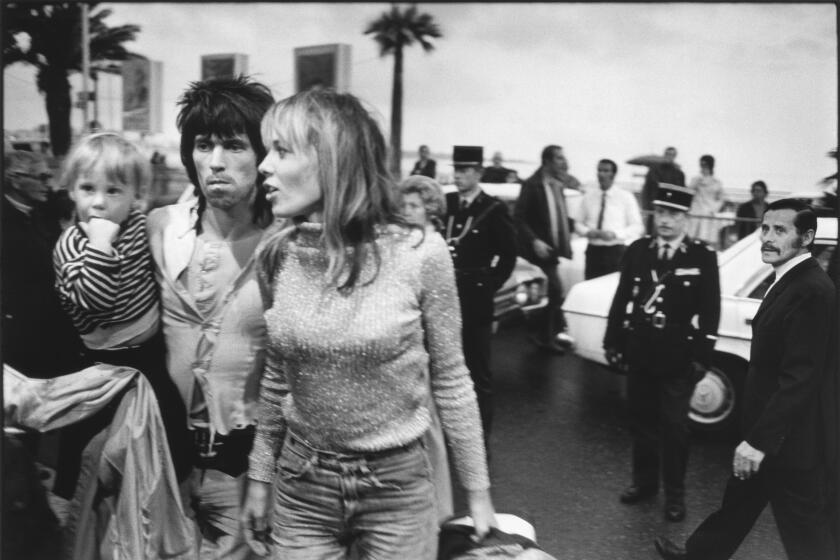‘Rings’ Around the Clock
To bring the timeless tale of “The Lord of the Rings: The Two Towers” to the big screen, director Peter Jackson embarked on a quest that would have made even his Hobbit hero Frodo tremble: to conquer time itself.
The latest film chapter of J.R.R. Tolkien’s epic work, which hits theaters this week, was produced by an army of more than 500 people that spanned 21 time zones across three continents. As animators in New Zealand finished painting the sneaky gleam in the eyes of the humanoid Gollum, artists in Los Angeles were touching up his translucent skin. Overseeing it all was Jackson, who kept tabs on every brush stroke while laboring over the movie’s soundtrack with an orchestra in London.
Somewhere, at any hour, someone was working on the film.
Banking on the power of the Internet and with the difference in time zones, movie productions such as “The Lord of the Rings” have become nonstop affairs, spawning a workday on which the sun never sets. The 24-hour cycle, which was tested during the production of the first movie in the “Rings” trilogy, already is being implemented for the third installment, “The Lord of the Rings: The Return of the King.”
“We don’t even bother asking what time it is anymore,” said a very tired John Clinton, project producer with visual effects shop Sony Pictures Imageworks in Culver City. “The movies never stopped. They never slept. Neither did we.”
Bits of the movie flowed through cyberspace from one city to the next, without so much as a pause. As Tolkien might say, the production relied on one vision to rule them all, one deadline to find them, one global computer system to bring them all and in cyberspace bind them.
In a 24-hour workday, the schedule is grueling. Each day is regimented with almost military-like precision, broken down minute by minute. But the absence of regular night-and-day cycles also can be incredibly confusing. Is the next conference call at 1 p.m. New Zealand time? Los Angeles time? London time?
But the payoff, as Jackson found, is the ability to create a film on the epic scale of “The Lord of the Rings” -- and not just one, but three at the same time.
Shifting production around the globe is already common in some quarters of the technology and entertainment worlds. The benefits typically include faster turn-rounds and cheaper labor costs, freeing specialists to focus on high-level work. But rarely has it been embraced as fully as it was by the makers of “The Two Towers.”
Take one “day” as an example. It’s 8 a.m. Friday in Wellington, New Zealand, time for the artists at Weta Digital, the effects and production company behind “The Two Towers,” to cram into a tiny office and begin one of a dozen international meetings the staff holds each day. Sipping a warm cup of tea, visual effects supervisor Jim Rygiel picks up a phone and dials.
An ocean away, the phone rings at Imageworks. Inside a cozy room, where the air hums with the sound of computer monitors, it’s noon Thursday in Southern California. A handful of artists greet the New Zealand crew and the two teams begin to study footage of the film.
As they speak, bits of data fly through the Net, zooming across millions of miles of cable. When translated onto a monitor, they arrange themselves into images of the film’s noble knights and fair maidens.
*
Across Time Zones
Halfway through the conversation, they place a call to Jackson, who’s at a rented house just outside London. The director joins the discussion about the skin tone of tree-like creatures called Ents. For him, it’s after 8 p.m. Thursday.
When the meeting ends more than two hours later, Jackson will head to bed. The Los Angeles team will be moving toward dinner time, while the New Zealand team is preparing to work through lunch.
“There just weren’t enough hours in the day to get everything done for all three films,” said co-producer, Barrie M. Osborne. “We used the Internet to cheat time.”
Such a system is familiar to technology workers. Silicon Valley firms routinely employ scores of programmers half a world away in places such as China and India to save money and squeeze more work into a project than a typical workday would allow. This type of project handoff was critical for programmers at the end of the millennium, as they raced to root out so-called Y2K bugs before Jan. 1, 2000.
International cooperation is also commonplace in the world of animation. At Film Roman, the North Hollywood studio that animates “The Simpsons” and “King of the Hill,” artists work for months at a time drawing and detailing scenes in an episode. Files are then shipped either in paper form by mail or in digital form via the Net to art houses in South Korea, where millions of frames are colored and finished.
*
Back and Forth
In the weeks before each episode airs, artists on both sides of the Pacific Ocean hand the project back and forth between secure computer servers to make minute changes from the director and writers. The work is painstaking, as a single editorial change can entail redrawing hundreds of frames.
“When we start getting down to the wire, it’s crucial that we use the Net for those kinds of last-minute changes,” said John Hyde, chief executive of Film Roman. “We need the technology to make our deadlines.”
Hollywood has long turned to technology as a means of creating more man-hours for a project. In 1994, long-distance provider Sprint Corp. and animation workstation maker Silicon Graphics Inc. launched a private telephone and computer network for the entertainment industry that allowed subscribers to transmit video or graphics in a matter of minutes.
Dozens of post-production and visual effects firms such as Digital Domain in Venice had hoped the system would help them cope with the dozens of time-consuming back-and-forth approval and editing sessions they would normally undergo with a project’s director. But the system, which cost as much as $30,000 a month to run, proved too costly for the budget-conscious entertainment industry.
Nonetheless, the idea of using technology to connect an increasingly global and fragmented motion-picture industry survived. Part of it was inspired by the massive number of film and television productions leaving Los Angeles in search of cheaper foreign locales.
While most productions go offshore to take advantage of tax breaks and lower wage rates, a side benefit is the continuous workday. That advantage is starting to catch on with other big-budget projects in production. “Peter Pan” and the next two installments of “The Matrix” series are filming overseas and using the Internet to send daily takes, director notes and other data back to their home studios in the United States.
Film companies in Australia and New Zealand have embraced this strategy and often tout the ease of access to high-speed data connections between their countries and the U.S.
In nearby Fiji, real estate developer Paradise Entertainment Ltd. is preparing to break ground next year on a 6,000-acre studio and post-production facility. One key selling point is the center’s location, right on the Southern Cross undersea optical cable, one of the world’s largest data pipes.
“Hollywood needs time,” said Taniela Bolea, chief executive of the Fiji Audio-Visual Commission. “We sit right on the international dateline, and right on a huge data pipe. It made sense to build on all that.”
But saving time can come with a price.
While brothers Andy and Larry Wachowski were directing the original “Matrix” movie in Sydney, studio executives at Warner Bros. insisted on seeing daily takes of the footage. Osborne, who was executive producer on the Keanu Reeves blockbuster, recalled that the crew in Australia used bundled high-speed ISDN lines and a software program to automatically send digital copies of video clips to the studio each night.
In theory, the system should have worked. But the software made an expensive mistake: If the computers in Sydney had difficulty staying connected to the computers at Warner Bros.’ offices in Burbank, the software would hang up and redial -- each time making a long-distance call.
“After not getting a phone bill for several months, I got one that amounted to several hundred thousand dollars,” Osborne said. “It was a nightmare, costing us a fortune and not producing any results.”
That experience, coupled with the realization that Jackson would be in London while the visual effects and sound editing work on “The Two Towers” was being done in New Zealand, led Osborne and the Weta staff to start dreaming up better ways to keep the director in the loop.
*
Networking
The team made a deal with Telecom New Zealand, the country’s largest communications provider, and Media.Net, a Manhattan Beach-based networking company. Working with local firms, they established a secure private data network between London and Weta’s offices in Wellington.
When the sun set in New Zealand, large data files containing sound tracks and digital clips of visual effects were sent to a server near the house Jackson was renting in England. He pulled the data onto a portable Apple iPod, then transferred the files to his laptop to review them.
“We would sit [in New Zealand] and Peter would play back the sound mix in London. He’d call us and say, ‘I’m ready to give you notes,’ ” said Christopher Boyes, an editor at Skywalker Sound who served as lead sound mixer on the project. “It was like having him at home.”
As Jackson and the Weta team spoke, their computers exchanged electronic commands that would allow either side to point out a specific detail on the screen or pull up a particular frame of footage.
It didn’t work smoothly at first.
“The files were moving too slowly,” Osborne said.
After scouring the network, Weta resolved the problem by upgrading the computers at the Wellington facility.
There was another hurdle: Even with 1,400 computers running 24 hours a day at Weta, the massive amount of rendering for the virtual characters and backgrounds in “The Two Towers” would take more than a year to finish. Looking to offload some work, Jackson tapped the visual effects staff at Imageworks.
“It was such a crazy schedule,” said Debbie Denise, executive vice president of production infrastructure for the Culver City operation. “We had two sets of clocks, one on New Zealand time and one on London time. We figured out what meeting we were in by what clock we were looking at.”
From Jackson’s perspective, the only thing that mattered was time. His specific focus was the end of October, his deadline for delivering the final edit of the film to the printers. They needed to make 10,000 copies of “The Two Towers” for this week’s release and couldn’t afford to wait.
“We were still finishing up the final sound mix as the plane was flying from New Zealand to Los Angeles with the print master,” Osborne said. “Sending the sound [to the lab] electronically saved us a day or two in delivery time. It gave Peter the extra time he needed.”
Jackson used every spare minute. The sound arrived a couple of hours before the printing machines started rolling.
More to Read
Only good movies
Get the Indie Focus newsletter, Mark Olsen's weekly guide to the world of cinema.
You may occasionally receive promotional content from the Los Angeles Times.






